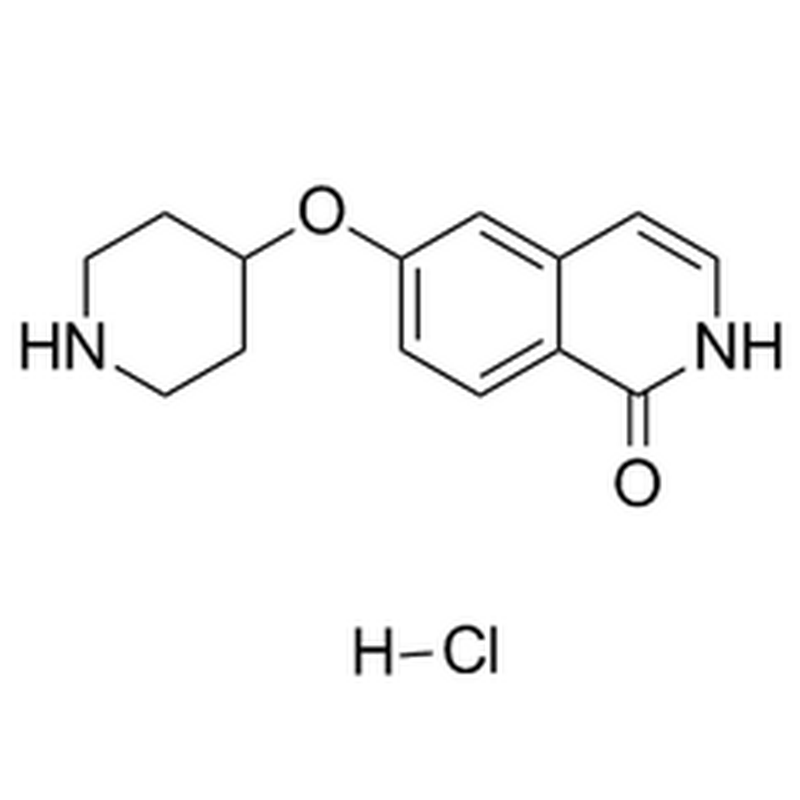产品
编 号:F521878
分子式:C14H17ClN2O2
分子量:280.75
分子式:C14H17ClN2O2
分子量:280.75
产品类型
规格
价格
是否有货
10mM*1mL in DMSO
询价
询价
2mg
询价
询价
5mg
询价
询价
10mg
询价
询价
50mg
询价
询价
100mg
询价
询价
结构图

CAS No: 923262-96-8
产品详情
生物活性:
SAR407899 hydrochloride is a selective, potent and ATP-competitive ROCK inhibitor, with an IC50 of 135 nM for ROCK-2, and Kis of 36 nM and 41 nM for human and rat ROCK-2, respectively.
体内研究:
SAR407899 (3 mg/kg, i.v.) inhibits ROCK-mediated phosphorylation of MYPTT696 in thoracic aorta of spontaneously hypertensive rats (SHRs). SAR407899 (0.01-0.30 mg/kg, i.v.) efficiently reduces pressor responses to vasoconstrictor agents in rats. SAR407899 (1, 3, 10, and 30 mg/kg, p.o.) dose dependently lowers blood pressure in hypertensive SHRs. SAR407899 (1-3 mg/kg, i.v. or 3, 10 mg/kg, p.o.) increases the length of the penis in healthy rabbits. SAR407899 (3-10 mg/kg, p.o.) also dose-dependently increases penile length in diabetic rabbits.
体外研究:
SAR407899 hydrochloride is a potent and ATP-competitive ROCK inhibitor, with Kis of 36 nM and 41 nM for human and rat ROCK-2, respectively. SAR407899 inhibits ROCK-2 better than ROCK-1, with IC50s of 102±19 nM and 276±26 nM, respectively, in the presence of 40 μM ATP. SAR407899 also less potently inhibits PKC-Δ and MSK-1, with IC50s of 5.4 and 3.1 μM, respectively. SAR407899 (0.1, 0.3, 1.0, and 3.0 μM) specifically inhibits the ROCK-mediated phosphorylation of MYPTT696 in HeLa cells stimulated with PHEN, and shows such effects at 1 μM and 10 μM in primary rat aortic smooth muscle cells. SAR407899 (3 μM) completely blocks thrombin-induced shrinkage of human umbilical vein endothelial cells (HUVECs) and stress fiber formation. SAR407899 concentration-dependently inhibits 5-bromodeoxyuridine incorporation into the cells with an IC50 of 5.0±1.3 μM. SAR407899 also effectively inhibits THP-1 migration with an IC50 of 2.5±1.0 μM. SAR407899 shows a potent vasorelaxant activity in a broad variety of isolated arteries taken from different vascular beds and species, with a range of IC50 values between 122 and 280 nM. SAR407899 dose-dependently relaxes the phenylephrine pre-contracted smooth muscle, with IC50s of 0.07 and 0.05 μM, respectively.
SAR407899 hydrochloride is a selective, potent and ATP-competitive ROCK inhibitor, with an IC50 of 135 nM for ROCK-2, and Kis of 36 nM and 41 nM for human and rat ROCK-2, respectively.
体内研究:
SAR407899 (3 mg/kg, i.v.) inhibits ROCK-mediated phosphorylation of MYPTT696 in thoracic aorta of spontaneously hypertensive rats (SHRs). SAR407899 (0.01-0.30 mg/kg, i.v.) efficiently reduces pressor responses to vasoconstrictor agents in rats. SAR407899 (1, 3, 10, and 30 mg/kg, p.o.) dose dependently lowers blood pressure in hypertensive SHRs. SAR407899 (1-3 mg/kg, i.v. or 3, 10 mg/kg, p.o.) increases the length of the penis in healthy rabbits. SAR407899 (3-10 mg/kg, p.o.) also dose-dependently increases penile length in diabetic rabbits.
体外研究:
SAR407899 hydrochloride is a potent and ATP-competitive ROCK inhibitor, with Kis of 36 nM and 41 nM for human and rat ROCK-2, respectively. SAR407899 inhibits ROCK-2 better than ROCK-1, with IC50s of 102±19 nM and 276±26 nM, respectively, in the presence of 40 μM ATP. SAR407899 also less potently inhibits PKC-Δ and MSK-1, with IC50s of 5.4 and 3.1 μM, respectively. SAR407899 (0.1, 0.3, 1.0, and 3.0 μM) specifically inhibits the ROCK-mediated phosphorylation of MYPTT696 in HeLa cells stimulated with PHEN, and shows such effects at 1 μM and 10 μM in primary rat aortic smooth muscle cells. SAR407899 (3 μM) completely blocks thrombin-induced shrinkage of human umbilical vein endothelial cells (HUVECs) and stress fiber formation. SAR407899 concentration-dependently inhibits 5-bromodeoxyuridine incorporation into the cells with an IC50 of 5.0±1.3 μM. SAR407899 also effectively inhibits THP-1 migration with an IC50 of 2.5±1.0 μM. SAR407899 shows a potent vasorelaxant activity in a broad variety of isolated arteries taken from different vascular beds and species, with a range of IC50 values between 122 and 280 nM. SAR407899 dose-dependently relaxes the phenylephrine pre-contracted smooth muscle, with IC50s of 0.07 and 0.05 μM, respectively.
产品资料

